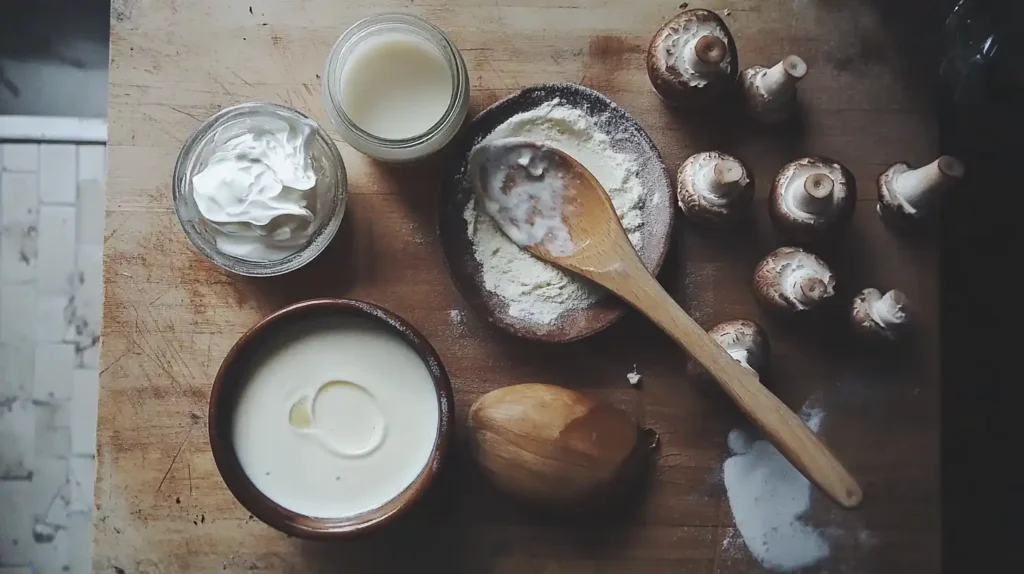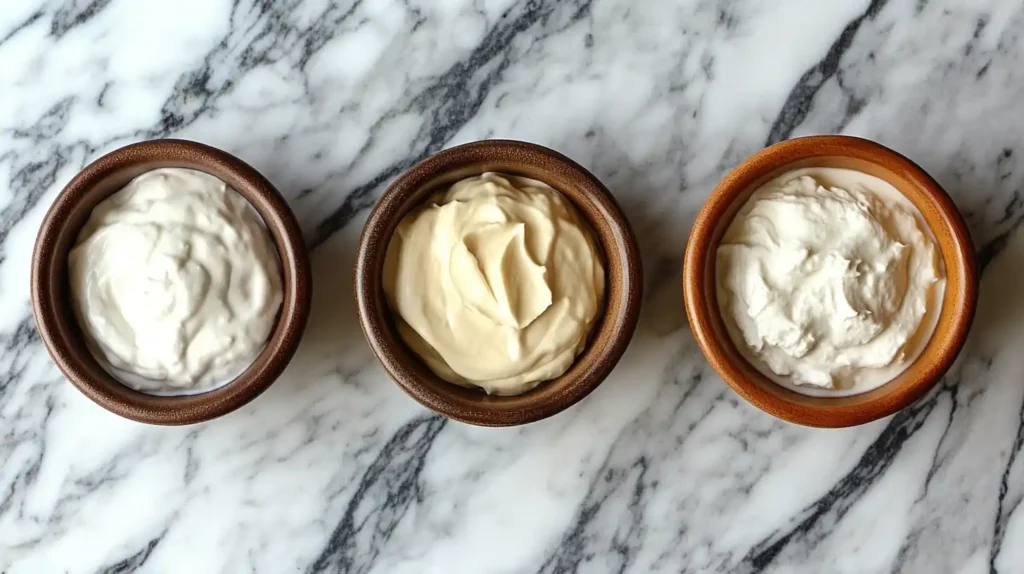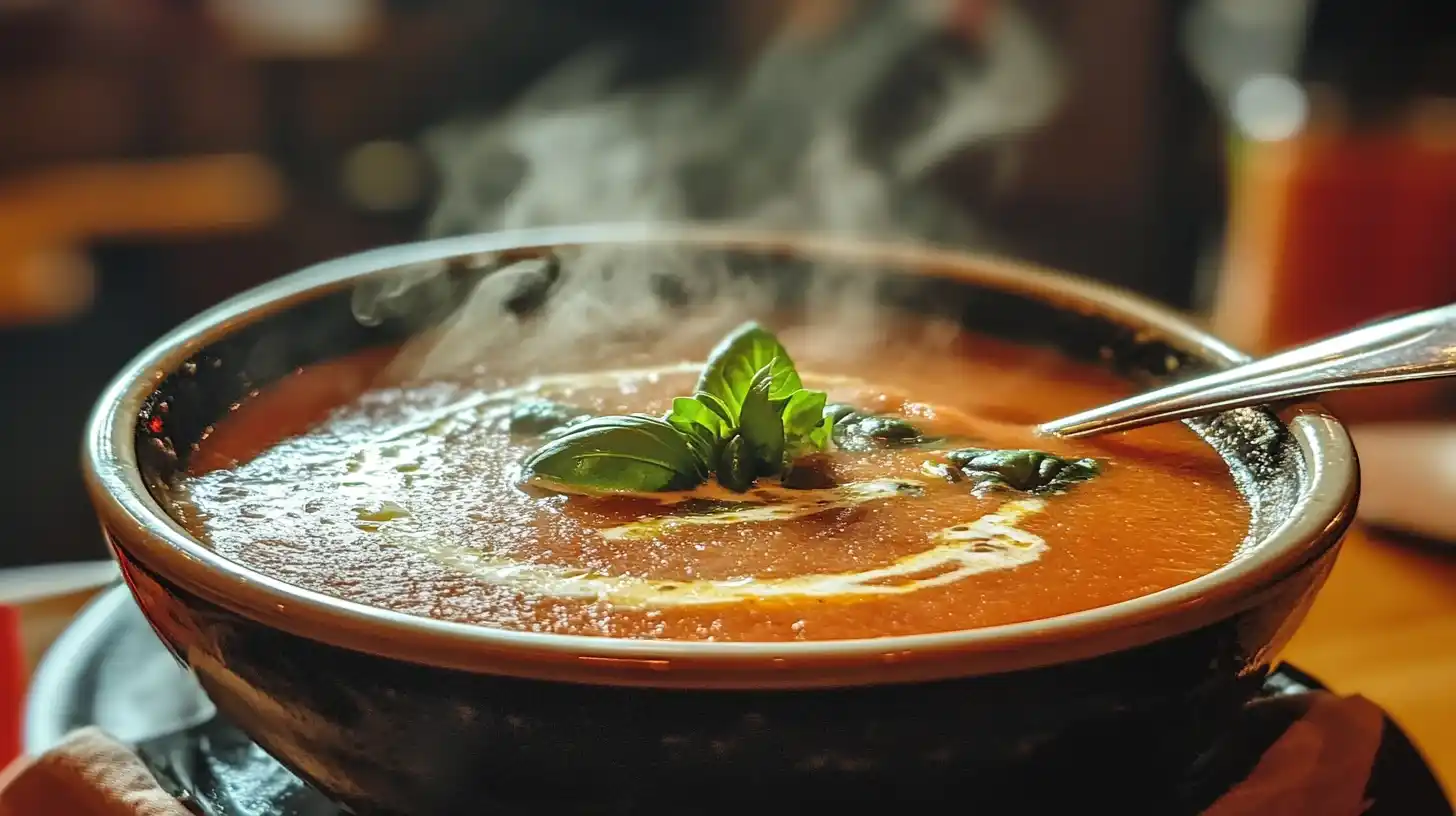Adding cream to soup is one of the simplest yet most effective ways to enhance its texture and flavor. Whether you’re making a velvety tomato bisque, a comforting mushroom soup, or a spicy chili, the type of cream you use and the way you incorporate it can make a huge difference. Some creams add a luxurious thickness, while others provide a delicate touch of richness. Knowing which cream to choose and how to use it correctly can take your soup from good to exceptional. In this guide, we’ll explore why cream is such a valuable addition to soups, the different types available, when to add it, and how to avoid common mistakes. By the end, you’ll have a full understanding of how to create soups that are irresistibly creamy and full of depth.
Make a comforting and creamy dish with our step-by-step guide: Irresistible Chili’s Baked Potato Soup Recipe.
Table of contents

Why Add Cream to Soup?
What type of cream do you add to soup? Adding cream does more than just make soup richer it transforms the overall experience of the dish. One of its biggest benefits is the smooth, velvety texture it creates. A well-blended soup with the right cream has a luxurious mouthfeel that enhances every bite.
Beyond texture, cream also deepens flavors by adding richness and balancing sharp or acidic ingredients like tomatoes or vinegar-based broths. This makes soups taste more harmonious and well-rounded.
If you enjoy spicy soups, cream acts as a spice balancer by toning down heat without dulling the overall taste. This is especially useful in recipes like jalapeño cream soup or spicy curries, where cream smooths out the intensity while adding body.
With its ability to enhance texture, flavor, and spice balance, cream is a versatile ingredient that plays a key role in countless soup recipes.

The Best Types of Cream for Soups
What type of cream do you add to soup? Choosing the right cream can make all the difference in texture and taste. Some creams offer a thick, luxurious consistency, while others provide a lighter, more delicate touch. Understanding their differences will help you create soups that are perfectly creamy and well-balanced.
Creamy Homemade Soup Base 🥣
A rich, velvety cream soup that serves as a base for countless variations chicken, mushroom, broccoli, or vegetable!
Ingredients:
- 3 tablespoons unsalted butter
- 1 small onion, finely chopped
- 2 cloves garlic, minced
- 3 tablespoons all-purpose flour
- 4 cups chicken broth (or vegetable broth)
- 1 cup of heavy cream, or opt for whole milk for a lighter alternative.
- ½ teaspoon salt (adjust to taste)
- ½ teaspoon black pepper
- ¼ teaspoon nutmeg (optional, for depth)
Optional Add-ins:
- Chicken: 1 cup shredded cooked chicken
- Mushrooms: 1 cup sliced mushrooms, sautéed
- Broccoli: 1 cup steamed broccoli, chopped
- Corn & Potatoes: ½ cup each, cooked
Directions:
- Sauté the Aromatics:
- Melt butter in a large pot over medium heat.
- Add onion and garlic, cooking until soft (3-4 minutes).
- Make the Roux:
- Add the flour and cook for 1-2 minutes, stirring continuously.
- Add the Liquid:
- Slowly whisk in broth until smooth and thickened (3-5 minutes).
- Make it Creamy:
- Reduce heat to low and stir in heavy cream, salt, pepper, and nutmeg.
- Customize Your Soup:
- Add cooked chicken, mushrooms, broccoli, or other veggies.
- Simmer for 5-10 minutes until heated through.
- Serve & Enjoy:
- Garnish with fresh herbs, cheese, or croutons and serve warm!
Details:
Prep Time: 10 mins | Cooking Time: 20 mins | Total Time: 30 mins | Calories: 250 per serving | Servings: 4
Heavy Cream – The Richest Option
With a fat content of 36-40%, heavy cream is the best choice for achieving a thick, velvety texture. Heavy cream gives pureed soups like tomato bisque, butternut squash soup, and creamy potato soup a rich, smooth consistency. One of its biggest advantages is its stability under heat, making it less likely to curdle when added to hot liquids. This makes it an excellent option for soups that require a rich, full-bodied finish without worrying about separation. Since it is the thickest option, it also helps create a more substantial, hearty soup that feels indulgent and comforting.
Whipping Cream – Light Yet Creamy
Whipping cream, with 30-35% fat, is a lighter alternative to heavy cream but still adds a smooth, creamy texture. It works well in mushroom soup, chicken soup, and light vegetable soups, enhancing richness without overpowering delicate flavors. While it doesn’t thicken soups as much as heavy cream, it blends beautifully with broth-based soups, creating a velvety consistency. This makes it ideal for recipes that need a hint of creaminess while maintaining a balanced, light texture.
Half-and-Half – A Lighter Alternative
Half-and-half, made from equal parts milk and cream, contains 10-18% fat. It’s a great choice for those who want a touch of creaminess without the heaviness of full cream. It works well in chowders, corn soup, and fresh vegetable soups, adding richness without making the dish too thick. However, since it has less fat than heavy or whipping cream, it is more likely to curdle if added directly to hot soup. To prevent this, tempering half-and-half before adding it is essential, ensuring a smooth and well-incorporated texture.
Non-Dairy Alternatives – Dairy-Free and Vegan Options
For those who prefer dairy-free or vegan options, there are several plant-based alternatives that still provide a creamy consistency. Coconut milk is a popular choice, offering a naturally sweet flavor that complements carrot soup, pumpkin soup, and Thai-inspired broths. Its thick texture mimics traditional cream while adding a slight tropical note. Almond milk has a mild nutty flavor and works best in light vegetable soups. It adds a subtle, creamy finish without overpowering other ingredients. Cashew cream, made by blending soaked cashews with water, is thick and neutral in flavor. It’s ideal for vegan soups that need a smooth, rich texture. Each dairy-free alternative offers a different level of creaminess, so the best choice depends on your soup.
When to Add Cream to Soup
The timing of adding cream to soup is just as important as choosing the right kind. What type of cream do you add to soup? Selecting the right cream can affect texture and flavor, and adding it at the wrong time may lead to curdling or separation. Follow these key steps to ensure a smooth, creamy consistency.
1. Add Cream at the End
One of the most important rules for achieving a smooth and creamy soup is adding cream toward the end of cooking. Cream is sensitive to heat, and if added too early, it can curdle, separate, or lose its silky texture. High temperatures break down the fat content in cream, which may cause an unpleasant grainy consistency instead of a rich, velvety finish.
To prevent this, wait until the soup is fully cooked and removed from direct heat before stirring in the cream. This allows it to blend smoothly without being exposed to prolonged heat. Stir slowly and evenly to ensure the cream is well incorporated into the soup. If the soup is still very hot, let it cool slightly before adding cream to reduce the risk of curdling.
What type of cream do you add to soup? The answer can affect how well your soup reheats. For soups that require reheating after cream has been added, use low heat and stir frequently to maintain consistency and prevent separation. If using a lower-fat cream, such as half-and-half or plant-based alternatives, extra care is needed since these are more likely to curdle when exposed to heat for too long.
By timing the addition of cream correctly, you can achieve a perfectly creamy soup with a smooth, well-balanced texture.
2. Temper the Cream
If your soup is very hot, adding cold cream all at once can create a temperature shock, leading to curdling. To avoid this, temper the cream by warming it slightly before mixing it into the soup. Take a small amount of hot soup, mix it with the cream in a separate bowl, and then gradually stir this mixture back into the pot. This slow introduction of heat ensures the cream blends seamlessly without affecting the soup’s consistency.
3. Avoid Boiling After Adding Cream
Once cream is added to soup, boiling should be avoided to maintain a smooth and creamy texture. High temperatures can break down the fat molecules in the cream, causing it to separate and develop a grainy or curdled appearance. Instead of a rich, velvety consistency, the soup may end up looking oily or lumpy, which can negatively affect both texture and taste.
To prevent this, keep the heat low to medium after adding cream. Allow the soup to gently simmer rather than reach a rolling boil. Stir occasionally to help the cream blend evenly without overheating. If the soup needs to be reheated after adding cream, do so slowly over low heat, stirring frequently to maintain a stable consistency.
This step is especially important for lower-fat creams, such as half-and-half, milk, or dairy-free alternatives, which are more prone to curdling under high temperatures. Non-dairy options like almond milk or cashew cream are particularly sensitive to heat and require extra care to avoid separation.
However, the best way to maintain a perfectly creamy soup is to control the temperature from the start. Always keep the heat low after adding dairy or plant-based cream. Let the soup stay warm but never reach a rolling boil, as excessive heat breaks down the cream’s structure, leading to curdling or a grainy consistency.

How to Pair Cream with Different Soups
Pairing the right type of cream with the right soup can enhance the dish’s overall taste and texture. Here are some of the best combinations:
1. Tomato Soup: Heavy cream is the best choice because it balances the acidity of tomatoes, creating a smooth, well-rounded flavor. Start with a small amount, around ¼ cup, and adjust based on your preference.
2. Mushroom Soup: Whipping cream works well with mushroom soup as it complements the earthy flavors without overwhelming them. Sautéing the mushrooms in butter before adding the cream enhances their depth.
3. Carrot or Butternut Squash Soup: Coconut milk is the ideal option, as its natural sweetness enhances the flavors of these vegetables. A small pinch of nutmeg or cinnamon can add extra warmth to the dish.
4. Spicy Soups (Curry or Chili-Based Soups): Heavy cream or cashew cream is recommended, as it helps balance the heat and brings a smooth, creamy consistency. Always add it gradually, tasting as you go to achieve the right balance.
5. Vegetable Soups: Half-and-half is a great choice when you want a light creaminess without overshadowing fresh vegetable flavors. Adding fresh herbs like dill or parsley at the end can bring an extra layer of brightness.
Frequently Asked Questions About Adding Cream to Soup
1. What is the best type of cream for soup?
The best cream depends on the soup. Heavy cream (36-40% fat) is ideal for thick, rich soups like tomato bisque and chowders. Whipping cream (30-35% fat) is slightly lighter and works well in mushroom or chicken soup. Half-and-half (10-18% fat) is a good option for those who want mild creaminess. Non-dairy alternatives like coconut milk, almond milk, or cashew cream are great for vegan or lactose-free soups.
2. When should I add cream to my soup?
Always add cream at the end of cooking, once the soup is off the heat. This prevents curdling and helps the cream blend smoothly.
3. How do I prevent cream from curdling in soup?
To avoid curdling, temper the cream by mixing it with a small amount of warm soup before adding it back to the pot. Also, avoid boiling the soup after adding cream, as high heat can cause separation.
4. Can I use milk instead of cream?
Yes, but milk has a lower fat content and is more likely to curdle. If using milk, choose whole milk for better texture, and temper it before adding to the soup.
5. Can I freeze soups with cream?
Soups with cream don’t freeze well because the dairy can separate when thawed. If you plan to freeze soup, add the cream after reheating for the best texture.
6. How much cream should I add to soup?
Start with ¼ to ½ cup per batch and adjust to taste. Add gradually to control the richness without overpowering the other flavors.
By following these tips, you can achieve smooth, creamy soups with perfect consistency every time!
Final Thoughts
Adding cream to soup is a simple but powerful way to elevate its flavor, texture, and overall appeal. Whether you prefer heavy cream for a rich finish or a dairy-free option for a lighter touch, the right choice enhances your dish. Follow best practices like adding cream at the right time, tempering it properly, and avoiding overheating. These steps ensure your soup stays smooth and satisfying. Experiment with different types of cream and soup pairings to discover the perfect combination for your taste.

